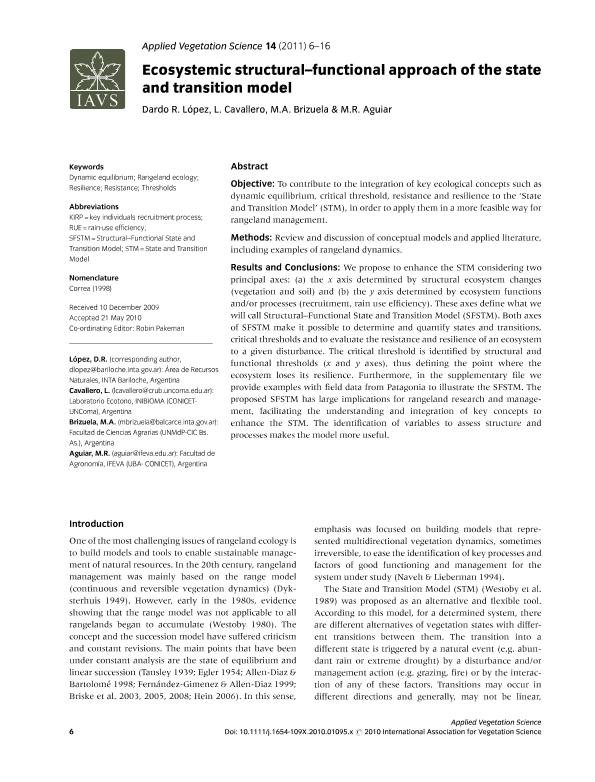Mostrar el registro sencillo del ítem
dc.contributor.author
López, Dardo Rubén

dc.contributor.author
Cavallero, Laura

dc.contributor.author
Brizuela, Miguel Angel

dc.contributor.author
Aguiar, Martin Roberto

dc.date.available
2020-02-11T14:30:17Z
dc.date.issued
2011-02
dc.identifier.citation
López, Dardo Rubén; Cavallero, Laura; Brizuela, Miguel Angel; Aguiar, Martin Roberto; Ecosystemic structural–functional approach of the state and transition model; Wiley Blackwell Publishing, Inc; Applied Vegetation Science; 14; 1; 2-2011; 6-16
dc.identifier.issn
1402-2001
dc.identifier.uri
http://hdl.handle.net/11336/97155
dc.description.abstract
Objective: To contribute to the integration of key ecological concepts such as dynamic equilibrium, critical threshold, resistance and resilience to the ‘State and Transition Model’ (STM), in order to apply them in a more feasible way for rangeland management. Methods: Review and discussion of conceptual models and applied literature, including examples of rangeland dynamics. Results and Conclusions: We propose to enhance the STM considering two principal axes: (a) the x axis determined by structural ecosystem changes (vegetation and soil) and (b) the y axis determined by ecosystem functions and/or processes (recruitment, rain use efficiency). These axes define what we will call Structural–Functional State and Transition Model (SFSTM). Both axes of SFSTM make it possible to determine and quantify states and transitions, critical thresholds and to evaluate the resistance and resilience of an ecosystem to a given disturbance. The critical threshold is identified by structural and functional thresholds (x and y axes), thus defining the point where the ecosystem loses its resilience. Furthermore, in the supplementary file we provide examples with field data from Patagonia to illustrate the SFSTM. The proposed SFSTM has large implications for rangeland research and management, facilitating the understanding and integration of key concepts to enhance the STM. The identification of variables to assess structure and processes makes the model more useful.
dc.format
application/pdf
dc.language.iso
eng
dc.publisher
Wiley Blackwell Publishing, Inc

dc.rights
info:eu-repo/semantics/openAccess
dc.rights.uri
https://creativecommons.org/licenses/by-nc-sa/2.5/ar/
dc.subject
DYNAMIC EQUILIBRIUM
dc.subject
RANGELAND ECOLOGY
dc.subject
RESILIENCE
dc.subject
RESISTANCE
dc.subject
THRESHOLDS
dc.subject.classification
Ecología

dc.subject.classification
Ciencias Biológicas

dc.subject.classification
CIENCIAS NATURALES Y EXACTAS

dc.title
Ecosystemic structural–functional approach of the state and transition model
dc.type
info:eu-repo/semantics/article
dc.type
info:ar-repo/semantics/artículo
dc.type
info:eu-repo/semantics/publishedVersion
dc.date.updated
2020-02-07T13:44:13Z
dc.journal.volume
14
dc.journal.number
1
dc.journal.pagination
6-16
dc.journal.pais
Reino Unido

dc.journal.ciudad
Londres
dc.description.fil
Fil: López, Dardo Rubén. Instituto Nacional de Tecnología Agropecuaria. Centro Regional Patagonia Norte. Estación Experimental Agropecuaria San Carlos de Bariloche; Argentina
dc.description.fil
Fil: Cavallero, Laura. Consejo Nacional de Investigaciones Científicas y Técnicas. Centro Científico Tecnológico Conicet - Patagonia Norte. Instituto de Investigaciones en Biodiversidad y Medioambiente. Universidad Nacional del Comahue. Centro Regional Universidad Bariloche. Instituto de Investigaciones en Biodiversidad y Medioambiente; Argentina
dc.description.fil
Fil: Brizuela, Miguel Angel. Provincia de Buenos Aires. Gobernación. Comisión de Investigaciones Científicas; Argentina. Universidad Nacional de Mar del Plata. Facultad de Cs.agrarias. Departamento de Producción Animal; Argentina
dc.description.fil
Fil: Aguiar, Martin Roberto. Consejo Nacional de Investigaciones Científicas y Técnicas. Oficina de Coordinación Administrativa Parque Centenario. Instituto de Investigaciones Fisiológicas y Ecológicas Vinculadas a la Agricultura. Universidad de Buenos Aires. Facultad de Agronomía. Instituto de Investigaciones Fisiológicas y Ecológicas Vinculadas a la Agricultura; Argentina
dc.journal.title
Applied Vegetation Science

dc.relation.alternativeid
info:eu-repo/semantics/altIdentifier/url/https://onlinelibrary.wiley.com/doi/abs/10.1111/j.1654-109X.2010.01095.x
dc.relation.alternativeid
info:eu-repo/semantics/altIdentifier/doi/https://doi.org/10.1111/j.1654-109X.2010.01095.x
Archivos asociados
